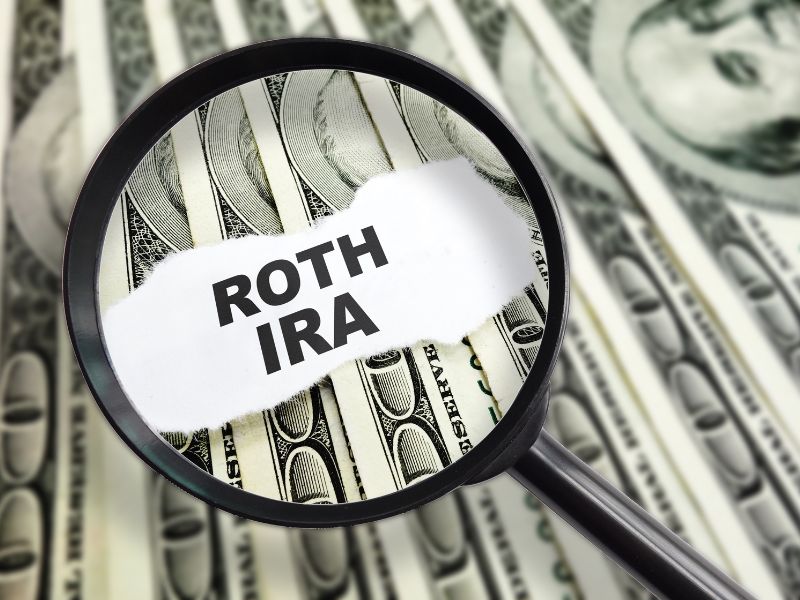Imagine turning a modest $1,700 investment into a tax-free fortune worth billions. Sounds impossible, right? But that’s exactly what Peter Thiel, the renowned venture capitalist and co-founder of PayPal, achieved using the power of a Roth IRA. In 1999, Thiel used his Roth IRA to purchase shares of PayPal at a fraction of a penny, a move that ultimately transformed his retirement account into a tax-sheltered goldmine.
While most people view Roth IRAs as a simple way to save for retirement, Thiel’s story reveals their hidden potential for extraordinary growth. Could you be overlooking the same opportunity to supercharge your retirement savings? Let’s delve into the world of Roth IRAs and uncover why this powerful investment vehicle deserves your attention.
Key Takeaways:
- Roth IRA is a special retirement account where you contribute after-tax money and enjoy tax-free withdrawals in the future.
- Ideal for individuals who expect their tax rate in retirement to be higher than their current rate.
- For 2024, the income eligibility limits are $230,000 for single filers and $240,000 for married couples filing jointly.
- The contribution limit for 2024 is $7,000 for individuals under 50 and $8,000 for those 50 and older.
- Available through most brokerage firms, banks, and investment companies.
What is a Roth IRA?
A Roth IRA (Individual Retirement Account) is a tax-advantaged retirement savings account that allows individuals to contribute after-tax income, enabling tax-free growth and withdrawals in retirement. Unlike traditional IRAs, where contributions may be tax-deductible, Roth IRA contributions are made with after-tax dollars.

How Does a Roth IRA Work?
When you contribute to a Roth IRA, you use money that has already been taxed. The account grows tax-free, and qualified withdrawals during retirement are also tax-free. This structure is beneficial if you anticipate being in a higher tax bracket when you retire.
Funding Your Roth IRA:
- Regular Contributions: Make consistent deposits from your earnings.
- Spousal IRA Contributions: Contribute on behalf of a non-working spouse.
- Rollover Contributions: Transfer funds from other retirement accounts like a 401(k).
- Conversions: Convert funds from a traditional IRA to a Roth IRA.
Note: Contributions must be made in cash; securities or property are not permitted.

The Advantages of a Roth IRA
Understanding the benefits of a Roth IRA can help you make an informed decision about your retirement savings:
- No Required Minimum Distributions (RMDs): Unlike traditional IRAs, Roth IRAs do not require you to take distributions during your lifetime, allowing your investments to grow tax-free for as long as you wish.
- Tax-Free Inheritance: Heirs can inherit Roth IRAs and enjoy tax-free withdrawals, provided the account was held for at least five years.
- Flexible Withdrawals: You can withdraw your contributions at any time without taxes or penalties. Earnings can be withdrawn tax-free if you meet the qualified withdrawal criteria.
- Double Dipping: You can contribute to both a Roth IRA and an employer-sponsored retirement plan like a 401(k), maximizing your retirement savings.
- No Age Limit to Open: As long as you have earned income, you can contribute to a Roth IRA regardless of your age.
How to Open a Roth IRA Account
Opening a Roth IRA is a straightforward process. Follow these steps to get started:
- Check Eligibility: Ensure you have earned income and meet the income limits set by the IRS.
- Choose a Provider: Select a trusted financial institution such as a bank, brokerage firm, or online platform.
- Complete the Application: Provide personal information including your name, address, and Social Security number.
- Designate Beneficiaries: Specify who will inherit your Roth IRA assets.
- Fund Your Account: Contribute up to the maximum limit set by the IRS. For 2024, the limits are $7,000 for individuals under 50 and $8,000 for those 50 and older. Check Contribution Limits.
- Choose Investments: Allocate your contributions to various investment options such as stocks, bonds, mutual funds, or ETFs.
- Monitor and Manage: Regularly review and adjust your investments to align with your financial goals.

Roth IRA Contribution Limits for 2024
Understanding the contribution limits is crucial for maximizing your retirement savings:
| Filing Status | Modified AGI | Contribution Limit |
|---|---|---|
| Married Filing Jointly or Qualifying Surviving Spouse | < $230,000 | Full Contribution ($7,000 or $8,000) |
| Married Filing Jointly or Qualifying Surviving Spouse | $230,000 – $240,000 | Reduced Contribution |
| Married Filing Jointly or Qualifying Surviving Spouse | > $240,000 | No Contribution |
| Married Filing Separately (Living with Spouse) | < $10,000 | Reduced Contribution |
| Married Filing Separately (Living with Spouse) | > $10,000 | No Contribution |
| Single, Head of Household, or Married Filing Separately (Not Living with Spouse) | < $146,000 | Full Contribution ($7,000 or $8,000) |
| Single, Head of Household, or Married Filing Separately (Not Living with Spouse) | $146,000 – $161,000 | Reduced Contribution |
| Single, Head of Household, or Married Filing Separately (Not Living with Spouse) | > $161,000 | No Contribution |
Note: If your income falls within the phase-out range, you need to calculate the exact amount you can contribute based on your Modified Adjusted Gross Income (MAGI). Refer to the IRS Publication 590-A for a detailed worksheet.
How to Calculate a Reduced Roth IRA Contribution
If your income exceeds certain thresholds, your Roth IRA contribution limit may be reduced. Follow these steps to calculate your reduced contribution:
- Determine Your Modified Adjusted Gross Income (MAGI): Start with your MAGI, which includes your adjusted gross income (AGI) plus certain deductions and exclusions.
- Subtract the Base Amount: Depending on your filing status, subtract the following:
- $230,000 if married filing jointly or as a qualifying surviving spouse.
- $0 if married filing separately and lived with your spouse at any time during the year.
- $146,000 for single, head of household, or married filing separately without living with a spouse.
- Calculate the Excess Income Ratio: Divide the result from step 2 by:
- $15,000 if married filing jointly, qualifying surviving spouse, or married filing separately while living with spouse.
- $10,000 for all other situations.
- Determine the Factor for Maximum Contribution: Multiply your maximum allowable contribution ($7,000 or $8,000) by the ratio obtained in step 3.
- Compute Your New Contribution Limit: Subtract the result from step 4 from your initial maximum contribution limit. This final number is your reduced contribution limit.
Always consult with a financial advisor or tax professional to ensure accurate calculations and compliance with IRS guidelines.
Benefits of a Roth IRA
A Roth IRA offers several advantages that make it a compelling option for retirement savings:
- Tax-Free Growth: Investments grow without being taxed, allowing your savings to compound more efficiently over time.
- Flexible Withdrawals: Withdraw your contributions at any time without penalties or taxes, providing financial flexibility.
- Legacy Planning: Pass on your Roth IRA to heirs, who can benefit from tax-free withdrawals.
- No Required Minimum Distributions: Unlike traditional IRAs, Roth IRAs do not mandate withdrawals during your lifetime, giving you greater control over your assets.
- Eligibility for All Ages: As long as you have earned income, you can contribute to a Roth IRA, regardless of your age.
What’s the Difference Between Roth and Traditional IRA?
Choosing between a Roth IRA and a Traditional IRA depends on your current and expected future tax situations:
| Feature | Roth IRA | Traditional IRA |
|---|---|---|
| Tax Treatment | Contributions are made with after-tax dollars; withdrawals are tax-free. | Contributions may be tax-deductible; withdrawals are taxed as ordinary income. |
| Withdrawal Rules | Qualified withdrawals are tax-free; contributions can be withdrawn anytime without penalty. | Withdrawals before age 59½ may incur taxes and penalties. |
| Required Minimum Distributions (RMDs) | None during the account holder’s lifetime. | Required starting at age 73. |
| Eligibility Based on Income | Subject to income limits. | No income limits for contributions, but tax deductibility may be limited based on income and participation in employer plans. |
For a more detailed comparison, check out our Roth vs. Traditional IRA Guide.
Roth IRA Rules and Penalties
Withdrawing Rules:
- You can withdraw your contributions at any time without penalties or taxes.
- Withdrawals of earnings are tax-free if you are at least 59½ years old and have held the account for at least five years.
- The IRS considers contributions to be withdrawn first.
Withdrawing Penalties:
- Withdrawing earnings before age 59½ may result in taxes and a 10% penalty unless it qualifies as a “qualified withdrawal.”
- Qualified withdrawals include:
- Buying your first home
- Paying for education expenses
- Health insurance premiums while unemployed
- Disability-related expenses
- Having a baby or adopting a child
Always consult with a tax professional to understand the specific rules and ensure compliance with IRS regulations. Claim your free consultation with our experts here!

Who is Eligible for a Roth IRA?
Eligibility to contribute to a Roth IRA is based on your filing status and Modified Adjusted Gross Income (MAGI). Here are the 2024 income thresholds:
Filing Status and Income Limits for 2024:
| Filing Status | Modified AGI | Contribution Limit |
|---|---|---|
| Married Filing Jointly or Qualifying Surviving Spouse | < $230,000 | Full Contribution |
| Married Filing Jointly or Qualifying Surviving Spouse | $230,000 – $240,000 | Reduced Contribution |
| Married Filing Jointly or Qualifying Surviving Spouse | > $240,000 | No Contribution |
| Married Filing Separately (Living with Spouse) | < $10,000 | Reduced Contribution |
| Married Filing Separately (Living with Spouse) | > $10,000 | No Contribution |
| Single, Head of Household, or Married Filing Separately (Not Living with Spouse) | < $146,000 | Full Contribution |
| Single, Head of Household, or Married Filing Separately (Not Living with Spouse) | $146,000 – $161,000 | Reduced Contribution |
| Single, Head of Household, or Married Filing Separately (Not Living with Spouse) | > $161,000 | No Contribution |
If your MAGI falls within the phase-out range, use the steps outlined above to calculate your reduced contribution limit.
Frequently Asked Questions (FAQ)
1. How do I calculate a reduced Roth IRA contribution if my income exceeds certain thresholds?
To calculate a reduced Roth IRA contribution:
- Determine your Modified Adjusted Gross Income (MAGI).
- Subtract the base amount based on your filing status:
- $230,000 for married filing jointly or qualifying surviving spouse.
- $0 for married filing separately and living with spouse.
- $146,000 for single, head of household, or married filing separately without living with spouse.
- Divide the result by $15,000 (or $10,000 for specific statuses).
- Multiply your maximum contribution limit by the ratio obtained.
- Subtract this amount from your maximum contribution limit to get your reduced limit.
Consult the IRS Publication 590-A or a financial advisor for precise calculations.
2. Can I have a Traditional IRA and Roth IRA at the same time?
Yes, you can have both a Traditional IRA and a Roth IRA simultaneously. However, the total annual contributions to both accounts cannot exceed the IRS limits.
3. How Much Can I Put in My Roth IRA Monthly?
For 2024, the maximum annual contribution is $7,000 for individuals under 50 and $8,000 for those 50 and older. This translates to approximately $583 per month for those under 50 and $667 for those 50 and older.
4. Can I Set Up a Roth IRA for My Spouse Who Doesn’t Work?
Yes, you can set up a spousal Roth IRA for a non-working spouse, provided you have sufficient earned income to cover both contributions.
5. What Should My Roth IRA Be Invested In?
Your investment choices within a Roth IRA depend on your risk tolerance and financial goals. Common options include:
- Stocks
- Bonds
- Mutual Funds
- ETFs
Diversifying your investments can help manage risk. Consider consulting a financial planner for tailored investment strategies.
Conclusion
A Roth IRA is a powerful retirement savings tool that offers tax-free growth and flexible withdrawal options. By contributing after-tax money, you can maximize your retirement savings and enjoy tax-free income when you retire. Understanding the contribution limits and eligibility requirements for 2024 is essential to optimize your retirement strategy.
Whether you’re just starting to save or looking to enhance your existing retirement plan, a Roth IRA can play a crucial role in achieving long-term financial security. If you have questions or need personalized guidance regarding retirement plans or any other financial matters, don’t hesitate to book a free consultation with our experts today!
>>> You may also like: Roth IRAs: Official Pros and Cons for Your Parents
Need help with your taxes or financial planning? Contact XOA TAX:
- Website: https://www.xoatax.com/
- Phone: +1 (714) 594-6986
- Email: [email protected]
- Contact Page: https://www.xoatax.com/contact-us/




 anywhere
anywhere  anytime
anytime